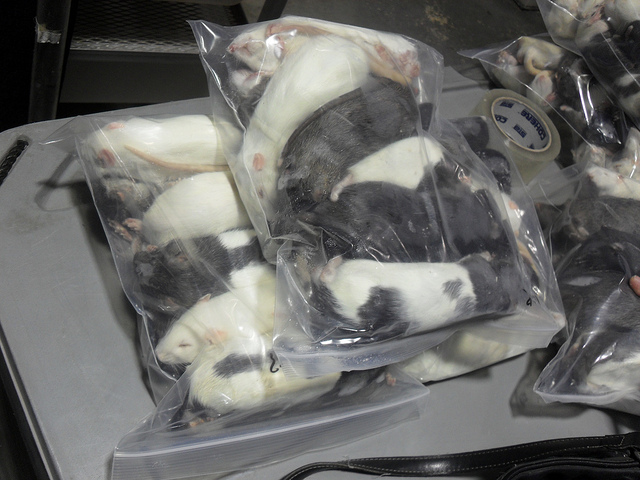How to Feed Frozen Mice to a Snake
Thawing Frozen Mice and Rats for Snakes and Other Reptiles
Frozen rodents are now widely available in the pet trade and, when used properly, are a safe food source that can save time, space and money. As opinions vary concerning proper thawing methods, I thought it might be useful to outline the procedures that are followed in major zoological parks. Based on the human food guidelines set down by the US Department of Health and Human Services and the US Department of Agriculture, they have served me well throughout my career as a zookeeper and herpetologist.
General Considerations
There are two safe methods that can be used to defrost rodents intended as reptile food – refrigeration and cold water. Microwave defrosting has certain drawbacks and should be avoided (please see below).

Frozen rodents purchased from a store or breeder should be re-packaged in clean zip-loc bags before being placed into your refrigerator, freezer or sink. Bowls into which these bags are placed (for warming or cold-water thawing, see below) should be reserved for that purpose…do not use bowls that will also hold your own food, even if the rodents are in clean bags. My apologies if this seems obvious, but I am continually amazed at how many people place their health in jeopardy while attempting to care for their pets!
Thawing Mice and Rats in a Refrigerator
Thawing under refrigeration is the method of choice in professional collections. It requires a bit of forethought, but is very safe and requires no effort on our part (other than moving the food item from freezer to refrigerator!).
Thawing time will vary in accordance with refrigeration temperature (usually 35-40 F). The USDA uses 8-10 hours per 1 pound of meat as a general guideline; a mouse can be expected to thaw in 2 hours, a rat in 4-5 hours.
Fail safe rule: place frozen rodents in a refrigerator for overnight thawing and use them the following day.
Thawing in Cold Water
This method is faster than via refrigeration, but requires periodic water changes, and leaves more room for error. Frozen rodents in zip-lock bags are placed in a bucket of cold water for 30 minutes, after which time the water is dumped and replaced. An adult rat can be thawed in as little as 1 hour.
The bags used should be leak-proof, lest harmful bacteria begin to colonize the food item.
Warming and Using Thawed Rodents
After thawing, rodents must be warmed somewhat before being fed to pet reptiles. This is best done by placing the bagged, thawed rodent in a bucket or other container of warm water. Timing varies, but plan on 10-20 minutes for a mouse in warm but not hot-to-the-touch water.
Use rodents shortly after thawing and warming. Whole animals contain internal organs, previously-consumed food, and unpassed wastes, and they decay rapidly.
Common Mistakes
Do not thaw rodents at room temperature or in hot water (this applies to our own food as well). Bacteria associated with disease and decay, which can be assumed present in all rodents, begin to reproduce at 40 F. Such bacteria can take hold on the thawed, outer surfaces of a food item despite the fact that its center is frozen.
Rodents should never be thawed in microwaves used for your own food. Thawing in a microwave reserved specifically for pet food is possible, assuming one can ascertain that the food item is completely thawed yet not partially cooked.
Rodents thawed under refrigeration can be re-frozen (if they have remained refrigerated). Rodents thawed in cold water should not be re-frozen.
2014-07-11
Source: http://blogs.thatpetplace.com/thatreptileblog/2014/07/11/thawing-frozen-mice-and-rats-for-snakes-and-other-reptiles/
0 Response to "How to Feed Frozen Mice to a Snake"
Post a Comment